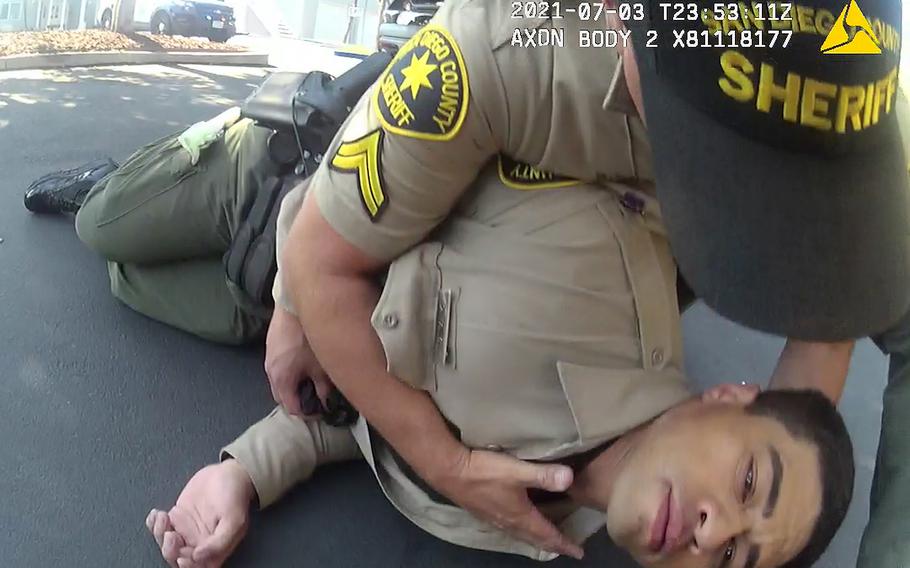U.S.
‘I’m not going to let you die’: San Diego deputy overdoses after coming in contact with fentanyl
The San Diego Union-Tribune August 7, 2021

According to the San Diego County Sheriff’s Department, one of its deputies was exposed to fentanyl in the field, requiring emergency life-saving intervention by a field training officer on the scene. (San Diego County Sheriff’s Department/TNS)
SAN DIEGO (Tribune News Service) — The accidental fentanyl exposure hit Deputy David Faiivae quickly. It was an overdose. He was dying.
A body-worn camera caught the moment Faiivae collapsed flat on his back in a San Marcos parking lot last month, seconds after he finished testing a white powder he’d suspected was either cocaine or fentanyl.
The sheriff’s deputy stared into the sky, his lungs locked as he struggled for air. If not for a quick-thinking partner, he would be dead.
Faiivae’s near-fatal overdose July 3 was the subject of a four-minute video released by the San Diego County Sheriff’s Department this week.
The incident is the latest public warning from officials about the dangers of fentanyl, a drug blamed for 461 fatal overdoses in San Diego County in 2020, with officials warning that number could hit 700 for 2021. The drug increasingly is being smuggled to inmates in county jails as well.
Undersheriff Kelly Martinez said the video prompted internal discussions about training, as well as the need to release it publicly, to demonstrate the dangers of fentanyl, a deadly synthetic drug 50 times more potent than heroin.
“We are still seeing it increasing all the time,” Martinez said of fentanyl use.
With body-worn cameras rolling, Faiivae’s training officer tells Faiivae the substance he found had tested positive for fentanyl. He cautions his trainee “that stuff’s no joke — it is super dangerous.”
Faiivae then takes a step backward and topples over.
Cpl. Scott Crane checks on the deputy and then races to his patrol car for naloxone, also known by the brand name Narcan, a nasal spray used to reverse the effects of opioids. “I ran over to him and I grabbed him, and he was OD‘ing,” Crane later recalled.
Crane sprays the medication into one of Faiivae’s nostrils, then the other and moves to loosen Faiivae’s bulletproof vest under his uniform shirt.
“Just breathe buddy, breathe,” Crane tells Faiivae, according to the video. When he asks his trainee if he is OK, Faiivae replies in a weak voice: “I’m sorry.”
“You’re OK. Don’t be sorry ... I got you, OK?” Crane says. “I’m not going to let you die. I’m not going to let you die.”
Faiivae’s overdose happened around 4 p.m. in a parking lot off North Twin Oaks Valley Road, during his first radio call of his day. The deputy works patrol out of the San Marcos sheriff’s station. It was his final day of shadowing the veteran Crane, officials said.
They are not sure if the fentanyl got onto the deputy’s skin or if he inhaled it.
Martinez, the undersheriff, credits Crane with having Narcan nearby as deputies tested the white powder. “He saved his partner’s life that day,” she said.
She also credits both deputies for agreeing to share their story, to underscore for the public the dangers of fentanyl.
“We are having secondary exposures. We’ve had toddlers exposed. It’s just so very dangerous,” she said.
On the video, Sheriff Bill Gore calls fentanyl one of the greatest threats facing the region and country. Overdoses have soared in recent years, Gore said, and deputies are finding the drug in the community — and in county jails.
“Every week sheriff’s deputies intercept fentanyl entering our (facilities),” he said. “When inmates overdose on fentanyl smuggled into our jails, deputies and nurses are saving dozens of lives every month” by administering naloxone.
The drug is so dangerous, someone exposed to even small amounts of the substance could face deadly consequences.
Gore urged viewers of the video to share it with family and friends in order to get the word out, saying it could save lives.
Law enforcement officials have long worried about officers being exposed to fentanyl, with some agencies buying tools that allow officers to test suspected narcotics without opening packages. Departments issue officers gloves and eye protection to lessen exposure risks.
Faiivae wore gloves as he tested the drug, Martinez said, and had just taken them off when he collapsed.
“I remember not feeling right and then I fell back,” Faiivae says on the video. “I don’t remember anything after that.”
He recalls gasping for breath but says it felt like his lungs locked up.
Crane remembers wanting the deputy to focus on his breathing — and to know he wasn’t alone.
After paramedics arrived, Faiivae was loaded into an ambulance and his eyes rolled back in his head. Crane said Faiivae overdosed the whole way to the hospital.
“It is an invisible killer,” Crane said. “He would have died in that parking lot if he was alone.”
———
©2021 The San Diego Union-Tribune. Visit sandiegouniontribune.com. Distributed by Tribune Content Agency, LLC.